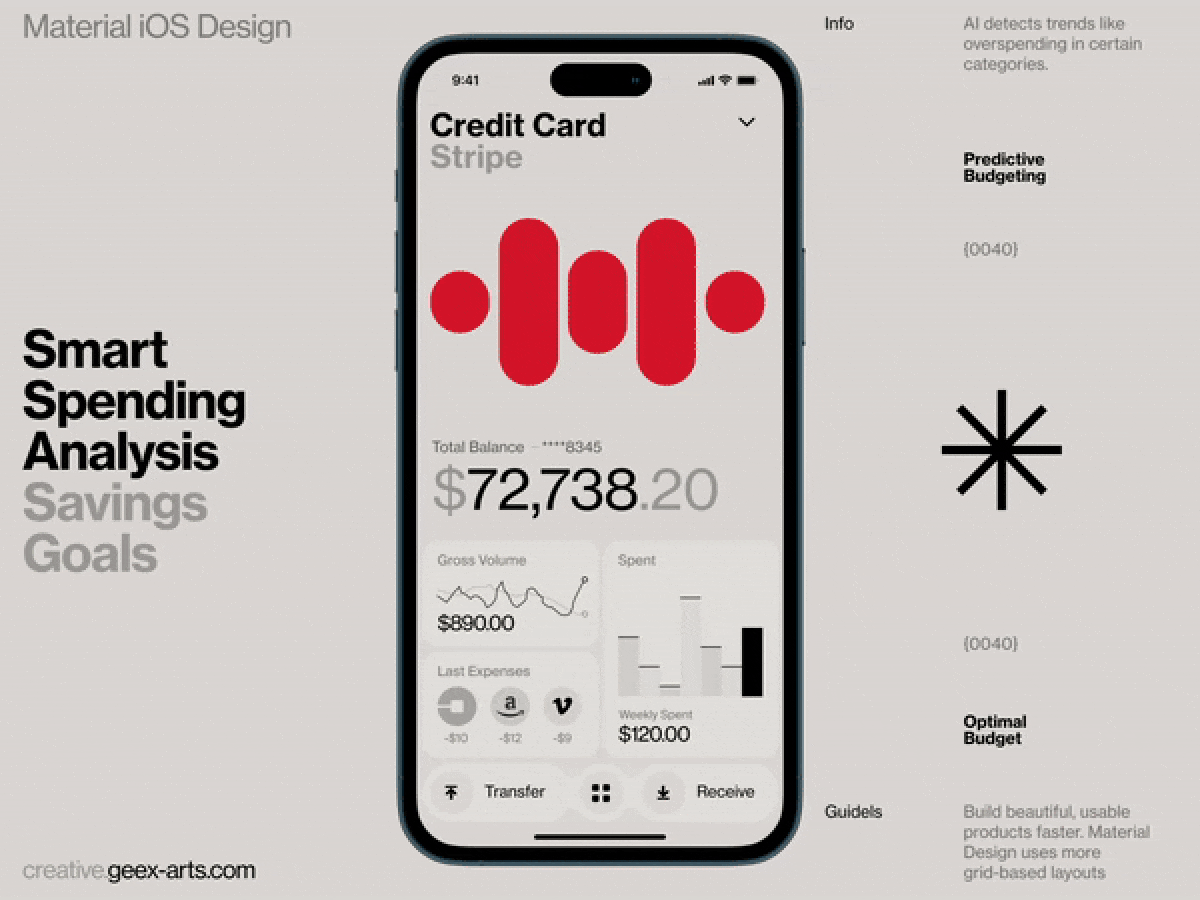Debit Cart by Slava Kornilov transforms debit cards into modern, aesthetic objects that reflect brand identity. Discover how minimalist, thoughtful design can influence user perception and enhance the experience of financial products.
In the world of digital design, debit cards are no longer just financial tools. They have become elements of a brand's visual identity, playing an essential role in the way a company is perceived by its customers. The 'Debit Cart' by Slava Kornilov, featured on Dribbble, is a perfect example of this trend, combining modern aesthetics with practical functionality. Let's explore the key elements of this design and how it's redefining the look of financial products.
Presentation of the work
Debit Cart' is the brainchild of Slava Kornilov, Art Director at Geex Arts, an agency renowned for its expertise in digital design and branding. The design features a sleek debit card with contemporary graphic elements that immediately grab attention. The card features a harmonious combination of geometric shapes, bold colours and modern typography, creating a balance between simplicity and sophistication.
Kornilov designed this card with the aim of reinventing the debit card user experience. Rather than focusing solely on functionality, he wanted to create an object that reflected an image of modernity and confidence. This approach goes beyond mere appearance: it aims to evoke positive emotions and make the user's interaction with financial products more enjoyable.
Design Features
The design of Debit Cart has several key features that make it a truly innovative creation:
- Minimalism: The card is characterised by a judicious use of space, avoiding superfluous elements in favour of a sober and elegant aesthetic. Minimalism is a strong trend in modern design, particularly for financial products, as it helps to convey a sense of simplicity and security. Fewer elements mean fewer distractions, allowing users to focus on what's important: using the card.
- Colour palette: Subtle, modern tones are used to give the card a professional yet attractive look. The choice of colours is essential to evoke emotions in the user: cool tones such as blue can inspire confidence, while brighter colours can convey innovation and modernity. Kornilov has skilfully chosen a palette that balances these emotions, making the card both inviting and trustworthy.
- Typography: A contemporary typeface is used to reinforce the visual identity of the card. Typography is an often underestimated element, but it plays a crucial role in the user experience. Here, the typeface chosen is clear, legible and modern, reflecting the product's desire for transparency and simplicity.
- Graphic elements: Subtle patterns and clean lines are incorporated into the design to add depth and character without visually cluttering the card. These graphic elements add a touch of uniqueness, differentiating the card from other similar products on the market. They also evoke a sense of movement and progress, reinforcing the idea that the card is a cutting-edge product.
Importance of debit card design
In an increasingly competitive financial market, debit card design plays a crucial role in how customers perceive the brand. Innovative design can not only attract new users, but also strengthen the loyalty of existing customers. Indeed, the appearance of a debit card can influence how a user feels when using it, giving them a sense of pride and belonging.
What's more, good design reflects a company's commitment to its customers. When users see that a company has invested time and resources in creating a product that is both functional and aesthetically pleasing, it reinforces their trust in the brand. Design then becomes a communication tool that conveys values such as innovation, quality and attention to detail.
Platforms such as Dribbble allow designers to share their creations and be inspired by current trends. By showcasing designs such as 'Debit Cart', Dribbble plays a crucial role in the development of industry standards and encourages the design community to constantly push the boundaries of creativity. It also allows companies to discover talent and be inspired by innovative concepts to improve their own products.
The Future of debit card design
As we move towards an increasingly digital future, the role of design in financial products will continue to grow. Users now expect products that are not only functional, but also beautiful and fun to use. Debit Cart is a perfect example of how designers can meet these expectations by combining aesthetics and utility.
In the future, we are likely to see even more customisable designs, allowing users to choose colours, patterns and even add personal elements to their cards. This personalisation will increase user engagement and make each card unique and valuable to them.
Conclusion
The 'Debit Cart' design by Slava Kornilov is a perfect example of the growing importance of design in the financial sector. By combining modern aesthetics with thoughtful functionality, this type of design is helping to redefine the user experience of financial products, making everyday interactions more enjoyable and rewarding.
If you're interested in the latest design trends and how they're influencing our relationship with financial products, check out more of Slava Kornilov's inspiring creations on Dribbble. Each design demonstrates the impact that design can have on our everyday lives, even in objects as mundane as a debit card. Discover how design can transform simple objects into memorable experiences.
Visit Slava Kornilov's page on Dribbble to learn more about his designs: Slava Kornilov on Dribbble.

Comments ()